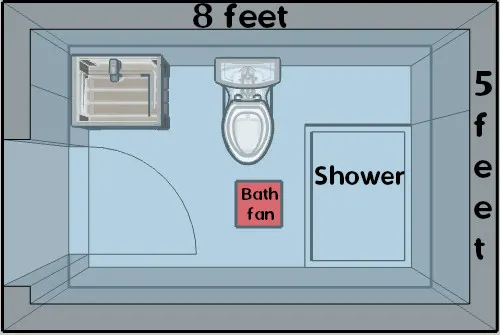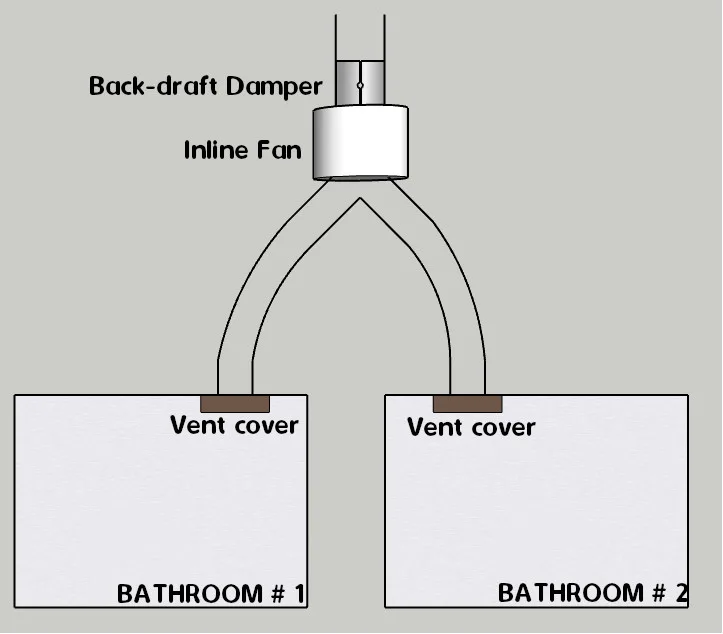The main purpose of installing an exhaust fan in the bathroom is to get rid of the moisture and control odors. When it comes time to replace the fan you might wonder if it is simply the case of plugging in the new fan or does it require more electrical know-how.
As a general rule, bathroom fans are hardwired. The fan housing has a junction box with a screw terminal. Cables from the power supply will be hardwired directly to the screw terminal inside the junction box.
However, when replacing only the motor, some models have a connector of some sort, and can be simply plugged in.
Lets dig deeper and find out is it really so difficult to connect the fan even though it is hardwired. Later I will also help you choose a new bathroom fan.
What Does Hardwired Mean
The term “hardwired” means that the appliance is permanently connected to the electrical system via a screw terminal and can not be plugged in and out. A cable from the house electrical system will be connected directly to the appliance. Hence it becomes hardwired.
If an item is wired directly into the house and can only be turned on and off with a switch, it is said to be “hardwired” when it comes to electrical appliances or light fixtures, a permanently installed fixture cannot be unplugged or moved.
Repairing it may necessitate shutting down power to that part of the building and replacing it will undoubtedly necessitate shutting down power to that part of the building. Light fixtures, ventilation fans and cooking ovens are examples of things that are usually hardwired.
Does a Bathroom Fan Need Its Circuit?
The bathroom fan does not need a dedicated circuit unless it has an integrated heater. The fan must have a dedicated 20-amp circuit if it has an integrated heater.
Because it only serves one appliance or fixture, this circuit is known as a “dedicated” circuit. Dedicated circuits may also be required for heat lamps, wall heaters, and other built-in heating appliances.
What Kind of Wire Do I Use for a Bathroom Fan?
The connection between the switch box and the fan unit: the number of switches used to operate the unit determines the gauge and type of wire used. Install a 14-2 wire set when installing a fan-only or a fan/light combination unit that operates on a single switch.
When operating a fan/light combination unit with two switches, use a 14-3 wire set. Two insulated and one bare 14-gauge wire strand are included in a 14-2 wire set, while three insulated and one bare wire strand is included in a 14-3 wire set. Heater-equipped units typically require a 12-2 for the heater option.
Does a Bathroom Fan Need to Be Connected to a GFCI?
A GFCI (ground-fault circuit interrupter) is a good way to prevent the hundreds of electrocutions in the United States each year. On the other hand, Bathroom fans may appear to pose little risk of electrocution because they are typically out of reach. So, some people might believe that GFCI protection is unnecessary.
Bathroom fans need to be connected to a GFCI branch circuit when placed in a shower or above a bathtub. In other cases, the GFCI is not required but recommended.
GFCI outlets should be installed in bathrooms, sinks, and other areas where there is standing or running water, according to most electricians. However, you might be curious about how this applies to specific bathroom appliances.
Find the Best Bathroom Fan
It can be challenging to decide in this day and age. There are far too many choices available. Bathroom fans are an excellent example of this.
Every manufacturer has ten models that are nearly identical in appearance but have different model names. When you’re confronted with so many options, it’s easy to become paralyzed by them. For the average household, the majority of the parameters they mention make no difference.
Below I supply some tips on choosing the best bathroom exhaust fan. Then, once you are fully equipped, you can head to the online stores to purchase the best bathroom fan for you.
Fan Size and Power
The amount of air moved by a bathroom exhaust fan is estimated in cubic feet per minute (CFM), which is the amount of air moved by the fan per minute.
The CFM number will be listed on the product’s box, along with a recommended room size. Homeowners should buy a fan with a minimum CFM rating equal to the square footage as a general rule of thumb. You could also use our bathroom fan CFM calculator to determine the optimal airflow.
Choose an Optimal Location
While the bathroom fan will exhaust moist air from the bathroom regardless of where it is placed, it will be more effective if it is placed near the shower.

The steam will be exhausted out of the home without difficulty, and fresh air will be drawn back into the bathroom via the gap under the door.
The advantage of this location over placing it above the shower is that the shower corner will stay much warmer. Because of the location, a light/fan combination is an excellent choice for keeping the bathroom as simple as possible.
Don’t be concerned if you can’t place the fan exactly where it appears in the photo. Everything should be fine. The exhaust fan should be placed close to the shower to provide efficient ventilation without sacrificing comfort.
Choose a Type Of Bathroom Fan
Ceiling-mounted, wall-mounted, and inline/remote bathroom exhaust fans are the three most common types.
Ceiling Exhaust fans
Ceiling exhaust fans are suspended from the ceiling and exhaust moist air out of the building via a duct and a roof vent.
Wall-Mounted Fan
When there is no practical way to vent through the roof, such as in a first-floor bathroom, wall-mounted fans are installed on the house’s exterior wall.
Inline fans

Inline fans have a fan unit in a remote setting, for example, the roof space. Ductwork joins the fan to a grill-covered opening in the bathroom ceiling. When an owner wants to use a single fan to vent several bathrooms or have various vents in a large bathroom, inline fans are a popular choice.
Cutout dimensions
The hole in your ceiling or wall where your existing fan is mounted is referred to as the cutout dimension. This determines the external dimensions of the fan housing. Remove the fan cover and measure the opening in the drywall/tiles to determine what it is for you.
If you cannot find an exhaust fan that perfectly fits the existing hole, go with a slightly larger fan and expand the hole in the ceiling/wall. For studying the dimensions in detail, click here.
Consider the Noise Level

In North America Bathroom, noise levels are measured in sones. A sone is a sound measurement because of how the average listener senses it. One sone equals a refrigerator’s light hum. A higher number of sones is a louder fan. It is recommended to install fans with 1.0 sones or less noise. Many models are available with ratings as low as 0.3 sones, making the exhaust fan much quieter.
Decibels are used in other parts of the world. You can find a Sone to Decibel Calculator Here.
How the Bathroom Fan Is Operated
There are several ways to turn on and off a bathroom fan, from a simple physical switch to a smart home controller setup from your computer.
This is not something you need to consider when buying the bathroom fan, but it might be helpful to think ahead and upgrade the switch, especially if you have a manual on/off switch. You can operate your bathroom fan according to the following ways.
- Physical On/Off switch (physically with the button).
- Timer Switch (via automating the time switch).
- Humidity Sensor/Switch (by using humidity sensors).



